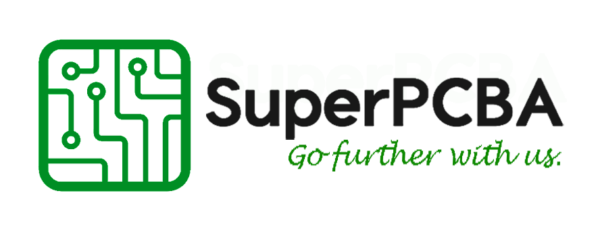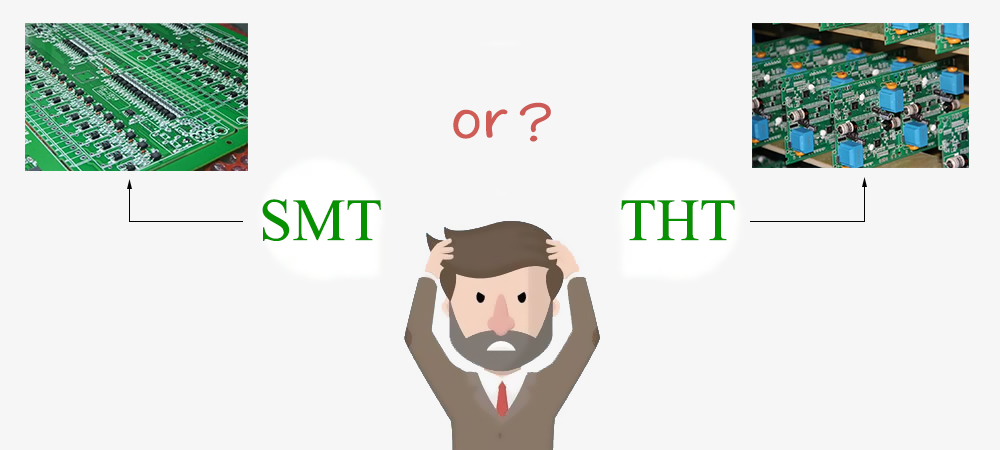Introduction
The mainstream installation methods for components on printed circuit boards (PCBs) are Through-Hole Technology (THT) and Surface Mount Technology (SMT). In the past few decades, SMT has become a popular installation method, often set as the default option by design engineers. However, both approaches have their advantages and should be carefully considered in high-reliability application designs. Today, based on our own design and manufacturing experience, SuperPCBA will analyze how to differentiate and choose between SMT and THT installation methods in practical applications. This analysis will cover the principles and process flow, pros and cons, design requirements and limitations, technological trends, and application scenarios of SMT and THT.
Principle and Process Flow:
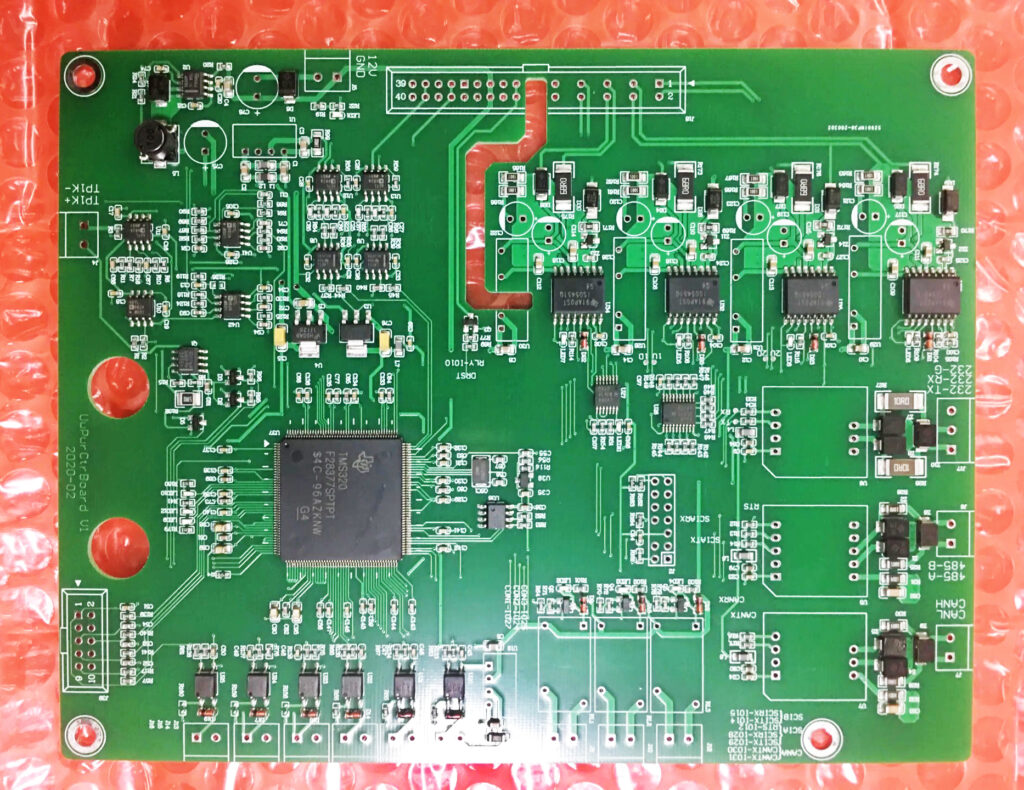
Basic Principles and Process Flow of SMT (Surface Mount Technology):
SMT is a method of component mounting where components are directly mounted on the surface of the circuit board, instead of being connected through drilled holes (through-hole). The pins or terminals of the components are connected to the solder pads on the surface of the circuit board through soldering or other connection techniques, achieving electrical and mechanical connections. The general process flow of SMT is as follows:
a. Preparations: Determine the circuit board design and component list, and prepare the necessary materials and equipment.
b. Grinding and cleaning: Polish and clean the circuit board to ensure a smooth surface free from dust, grease, and other contaminants.
c. Glue application: Apply adhesive onto the solder pad positions on the circuit board to provide bonding.
d. Component placement: Use automated pick-and-place machines to precisely position the components onto the solder pads of the circuit board.
e. Soldering: Connect the pins of the components to the solder pads on the circuit board through heat melting or other methods, forming reliable electrical connections.
f. Inspection and correction: Inspect the soldering quality using visual inspection or automated inspection equipment and make corrections if necessary.
g. Cleaning and coating: Clean and coat the circuit board to protect the components and solder pads, providing additional mechanical and environmental protection.
h. Testing and quality control: Perform functional testing and quality control to ensure the performance and reliability of the circuit board meet the requirements.
i. Final assembly: Add other components (such as plug-in components, connectors, etc.) to the circuit board to complete the final assembly.
Basic Principles and Process Flow of THT (Through Hole Technology):

THT (Through-Hole Technology) involves inserting the pins of components into pre-drilled holes on the circuit board and then connecting them to the board through soldering or other securing methods. These holes are typically coated or plated with metal to form solder pads for connecting the component pins. The general process flow of THT is as follows:
a. Preparations: Determine the circuit board design and component list, and prepare the necessary materials and equipment.
b. Drilling: Use a drill or drilling machine to create holes on the circuit board for inserting the component pins.
c. Cleaning and polishing: Clean and polish the circuit board to ensure that the holes are free from dust, grease, and other contaminants.
d. Component insertion: Manually or automatically insert the component pins into the holes of the circuit board, ensuring alignment and proper insertion depth.
e. Soldering: Use wave soldering or manual soldering methods to solder the component pins to the solder pads on the circuit board, creating reliable electrical connections.
f. Trimming and forming: Trim the excess pin length and use tools to shape and trim the pins.
g. Inspection and correction: Inspect the soldering quality using visual inspection or testing equipment and make corrections if necessary.
h. Cleaning and coating: Clean and coat the circuit board to protect the components and solder pads, providing additional mechanical and environmental protection.
i. Testing and quality control: Perform functional testing and quality control to ensure the performance and reliability of the circuit board meet the requirements.
j. Final assembly: Add other components (such as SMT components, connectors, etc.) to the circuit board to complete the final assembly.
The Pros and Cons of SMT and THT:
Please note that the table above lists the general pros and cons, and specific application scenarios may vary. Choosing the appropriate mounting method is an important decision based on specific project requirements and design considerations.
| Characteristics | SMT | THT |
| Size | Smaller, occupying less space. | Larger, occupying more space. |
| Soldering Reliability | High reliability, suitable for small-sized components. | High reliability, suitable for high-power components. |
| Repair and Replacement | Difficult, requiring specialized tools and techniques. | Relatively easy, without the need for specialized tools. |
| High-Frequency Performance | Suitable for high-frequency applications. | Limited high-frequency characteristics, poorer anti-interference capability. |
| Technical Requirements | Requires high-precision equipment and specialized skills. | Lower technical requirements, easier to get started with. |
| Automation Level | Highly automated, resulting in high production efficiency. | Manual operation, resulting in lower production efficiency. |
| Visibility | Pins are difficult to observe and inspect. | Pins are clearly visible, making visual inspection easier. |
| Cost Effectiveness | Lower cost, suitable for large-scale production. | Higher cost, suitable for small-batch production. |
| Environmental Friendliness | Uses a small amount of solder, low environmental impact. | Uses a larger amount of solder, greater environmental impact. |
| Production Cycle | Shorter production cycle. | Longer production cycle. |
Design Requirements and Limitations
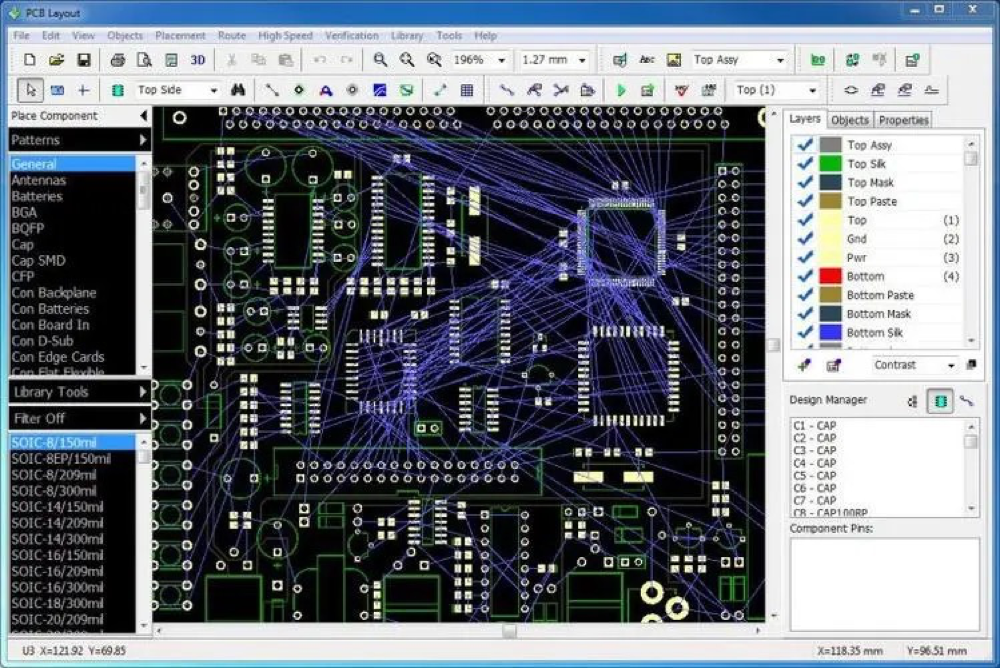
Requirements and limitations of SMT on PCB design:
Component Package Types: SMT requires the use of specific component package types, such as surface-mount integrated circuits (ICs), capacitors, resistors, etc. These components typically have flat pins, such as chip-sized or no-lead packages.
Pad and Solder Joint Design: Pads are the primary means of connecting component pins to the circuit board, so their design is crucial. Pads should match the size and spacing of the component pins, and appropriate clearances and arrangement should be considered to ensure proper soldering and reliability.
Trace Layout: SMT requires a compact trace layout to minimize the spacing between components and the size of the circuit board. This includes optimizing component placement, routing of traces, and minimizing crossovers to ensure good signal integrity and circuit board performance.
Design Rules and Dimensions: Circuit board design needs to comply with the design rules and requirements provided by SMT manufacturers. These rules include pad sizes, component spacing, minimum line width/spacing, etc. Considering these limitations in the design process ensures successful manufacturing and reliability.
Thermal Management: The high-density layout and high-power characteristics of SMT components can lead to heat accumulation and heat dissipation issues. Therefore, appropriate thermal management solutions, such as heat pads, heat vias, thermal copper areas, etc., should be considered in the circuit board design to ensure components operate within their normal temperature range.
Special Requirements and Assembly Techniques: Certain special components or applications may require specific design and assembly techniques. For example, components with Ball Grid Array (BGA) packages require careful consideration of ball layout and pin connections. These special requirements need close collaboration with manufacturers and assembly providers to ensure the feasibility and reliability of the design.
In summary, SMT imposes a set of requirements and limitations on circuit board design, requiring comprehensive considerations in component selection, layout design, dimension specifications, etc., to ensure the final design meets manufacturing requirements and reliability standards.
Requirements and limitations of THT on PCB design:
Component Pin Types: THT requires the use of components with pins or sockets, which are typically inserted into designated holes on the circuit board. Common THT components include sockets, switches, relays, etc.
Hole Design: Holes are the primary means of mounting THT components, so their design is crucial. The hole diameter and spacing should match the size of the component pins, and consideration should be given to ease of insertion and removal for ensuring reliable connections.
Trace Layout: Unlike SMT, THT components usually require larger spacing and space, allowing for a more relaxed trace layout. However, it is still necessary to arrange component positions and routing in a logical manner to ensure signal integrity and circuit board performance.
Design Rules and Dimensions: Similarly, THT designs need to adhere to design rules and requirements provided by manufacturers. This includes hole sizes, component spacing, line widths/spacing, etc. Complying with these rules ensures successful manufacturing and reliability.
Stability and Reliability: Since THT components are inserted and soldered onto the circuit board, designs require sufficient stability and reliability. This may involve increasing insertion force, providing additional mechanical support, or using locking devices.
Special Requirements and Assembly Techniques: Certain special THT components or applications may require specific design and assembly techniques. For example, large plugins, high-power components, or components requiring special cooling measures. These requirements necessitate close collaboration with manufacturers and assembly providers to ensure feasibility and reliability of the design.
In summary, THT imposes a set of requirements and limitations on circuit board design. It requires comprehensive considerations in component selection, hole design, trace layout, and other aspects to ensure the final design meets manufacturing requirements and reliability standards.
Technology Trends and Applications
The latest trends and applications in SMT include:

Miniaturization and High Integration: With the increasing demand for smaller and lighter electronic products, SMT technology is evolving towards smaller and more compact solutions. Component sizes are getting smaller, and pin spacing is becoming tighter to achieve higher integration and performance.
High Speed and High Density: Modern electronic devices require higher data rates and more complex functionalities, driving SMT technology to pursue higher speed and density. High-speed SMT production lines, advanced placement machines, and higher resolution screen printing techniques contribute to increased production efficiency and component density.
High Reliability and Durability: Reliability of SMT assembly has always been a focus, especially for electronic devices used in harsh environments. Recent years have seen advancements in technology and material improvements, such as advanced lead-free soldering techniques, reliable surface coatings, high-temperature resistant materials, etc., to provide enhanced reliability and durability.
Multi-Functionality and Multi-Material Assembly: SMT technology is not limited to traditional electronic components but can also be applied to assemble components with various functions and materials. For example, SMT is used in flexible electronics, 3D packaging, system-in-package (SiP), and other fields to enable the assembly of more complex electronic devices.
Specialized Application Areas: SMT technology is widely applied in various industries, such as automotive electronics, medical devices, aerospace, etc. These industries often have higher requirements for reliability and temperature resistance, driving the continuous development of SMT applications in these fields.
Intelligent Manufacturing and Automation: With the rise of Industry 4.0 and intelligent manufacturing, SMT production lines are becoming more automated and intelligent. The application of automated placement machines, intelligent inspection devices, data analytics, and optimization techniques improves production efficiency, reduces costs, and enables more precise quality control in SMT assembly.
These trends and applications highlight the ongoing advancements in SMT technology, driven by the need for smaller, faster, more reliable, and multifunctional electronic devices, as well as the increasing demand for intelligent and automated manufacturing processes.
The latest trends and applications in THT (Through-Hole Technology) include:

High-Reliability Applications: THT technology is still common in applications that require high reliability, such as aerospace, defense, and medical equipment. These industries have strict requirements for the reliability and durability of circuit boards, and THT technology can provide more stable and durable connections.
High-Power and High-Current Applications: THT technology is suitable for applications that involve high power and high current transmission. Through-hole soldering provides better conductivity and heat transfer capabilities, making THT technology a reliable choice for electronic devices that handle high power and high current.
Special Component Mounting: Certain component types, such as large capacitors, connectors, relays, and heat sinks, may not be suitable for SMT placement due to their larger size or special shape. THT technology is a common choice for the installation of these special components.
Rapid Prototyping: During the prototyping stage, THT technology offers lower design and manufacturing costs, allowing for quick validation and testing of circuit designs. For projects that require rapid iteration and prototype verification, THT technology provides an economically effective solution.
Repair and Maintenance: Some older electronic devices or equipment that have aged may have a large number of THT components. To repair and maintain these devices, continuing to use THT technology allows for convenient replacement and repair of components.
Applications
SMT Applications

SMT (Surface Mount Technology) applications are wide-ranging in the electronics industry. Here are some common scenarios:
Consumer Electronics: SMT technology is widely used in consumer electronic products such as smartphones, tablets, televisions, audio devices, and more. These products often have small form factors and high-density circuit boards, and SMT technology can meet their design requirements.
Communication Equipment: SMT technology is commonly employed in communication devices like wireless routers, base station equipment, communication modules, and others. These devices require high-performance and high-frequency circuit board designs, and SMT provides better signal transmission and interference resistance.
Automotive Electronics: Modern automobiles extensively utilize electronic systems and control modules with numerous SMT components. From engine control units to in-vehicle entertainment systems, SMT technology offers efficient and reliable solutions.
Medical Equipment: Diagnostic devices, monitoring equipment, surgical devices, and other medical equipment utilize SMT technology. These devices demand precision, stability, and reliability, all of which can be met by SMT technology.
Industrial Control and Automation: SMT technology is widely adopted in industrial control systems, automation equipment, and robots. These devices require high-speed communication, precise control, and stability, all of which SMT technology can provide in industrial environments.
LED Lighting: SMT components, including LED chips and driver circuits, are extensively used in LED lighting products. SMT technology enables efficient assembly and heat management for energy-efficient and sustainable lighting solutions.
It’s worth noting that the application of SMT technology is not limited to the above-mentioned fields. With technological advancements and innovations, the application of SMT continues to expand into more industries and domains.
THT Applications
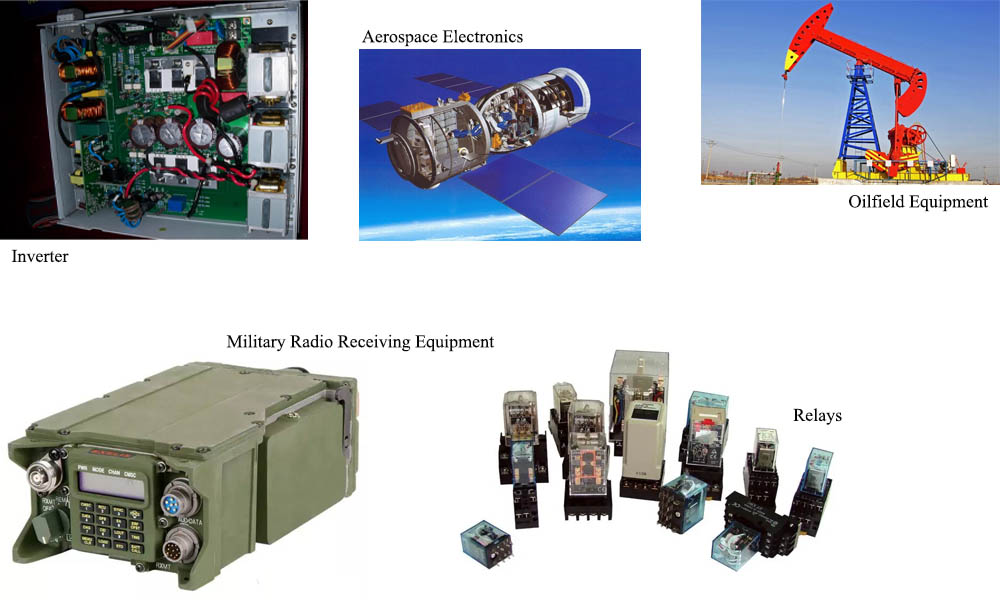
The applications of THT (Through-Hole Technology) remain widespread in specific scenarios, despite being replaced by SMT technology in some fields. Here are some specific application scenarios where THT is still extensively used:
High-Power Electronics: In applications that require handling high current and power, THT technology can provide better current-carrying capabilities compared to SMT technology. For example, power modules, inverters, and motor drives commonly employ THT technology in high-power electronic devices.
Harsh Environment Applications: In environments characterized by high temperature, high humidity, severe vibrations, or strong corrosion, THT technology offers better soldering reliability. THT technology is commonly used in fields such as military equipment, aerospace electronics, and oilfield equipment.
Mechanical Fixation and Connection: THT technology’s soldering connections are generally more robust compared to SMT technology. In applications that require withstanding mechanical stress and vibration, THT technology is more suitable. Devices such as connectors, relays, switches, and others typically utilize THT technology.
Legacy Equipment: Some older devices or system designs still rely on THT technology without undergoing modernization updates. These devices are often not easily adaptable to SMT technology, so THT technology continues to be relevant in terms of maintenance and repair.
Conclusion
The above is SuperPCBA’s analysis, comparison, and summary of SMT and THT component assembly based on their more than ten years of experience in PCB design, production, and assembly. We hope this information can assist every customer and friend in need. Our company also offers TurkeyPCBA services, which are convenient, efficient, high-quality, and cost-effective. We welcome all new and existing customers to come and discuss and cooperate with us.
